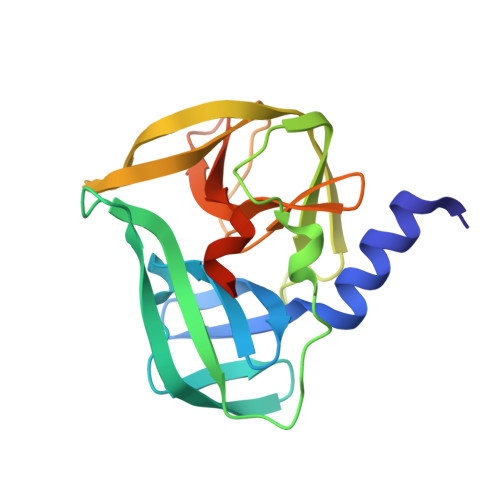Fragment-wise design of inhibitors to 3C proteinase from enterovirus 71
Wu, C., Zhang, L., Li, P., Cai, Q., Peng, X., Yin, K., Chen, X., Ren, H., Zhong, S., Weng, Y., Guan, Y., Chen, S., Wu, J., Li, J., Lin, T.(2016) Biochim Biophys Acta 1860: 1299-1307
- PubMed: 26987809
- DOI: https://doi.org/10.1016/j.bbagen.2016.03.017
- Primary Citation of Related Structures:
5DP3, 5DP4, 5DP5, 5DP6, 5DP7, 5DP8, 5DP9, 5DPA - PubMed Abstract:
Enterovirus 71 (EV71) is a causative agent of hand, foot and mouth disease (HFMD), which can spread its infection to central nervous and other systems with severe consequence. A key factor in the replication of EV71 is its 3C proteinase (3C(pro)), a significant drug target. Peptidomimetics were employed as inhibitors of this enzyme for developing antivirals. However, the peptide bonds in these peptidomimetics are a source of low bioavailability due to their susceptibility to protease digestion. To produce non-peptidomimetic inhibitors by replacing these peptide bonds, it would be important to gain better understanding on the contribution of each component to the interaction and potency. A series of compounds of different lengths targeting 3C(pro) and having an α,β-unsaturated ester as the warhead were synthesized and their interactions with the enzyme were evaluated by complex structure analyses and potency assays for a better understanding on the relationship between potency and evolution of interaction. The P2 moiety of the compound would need to be oriented to interact in the S2 site in the substrate binding cleft and the P3-P4 moieties were required to generate sufficient potency. A hydrophobic terminal group will benefit the cellular uptake and improve the activity in vivo. The data presented here provide a basis for designing a new generation of non-peptidomimetics to target EV71 3C(pro).
Organizational Affiliation:
The First Affiliated Hospital of Xiamen University, Xiamen, Fujian, China; State Key Laboratory of Cellular Stress Biology, Innovation Center for Cell Signaling Network, State-Province Joint Engineering Laboratory of Targeted Drugs from Natural Products, School of Life Sciences, Xiamen University, Xiamen, Fujian, China.















